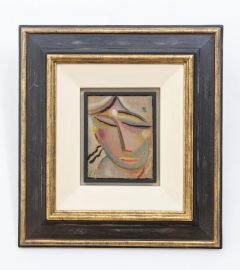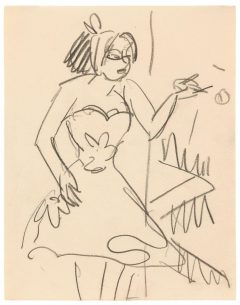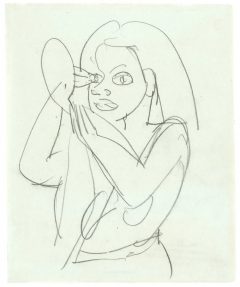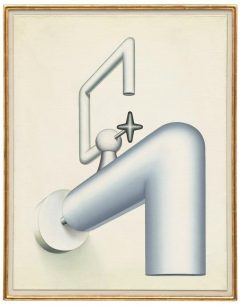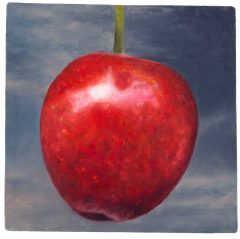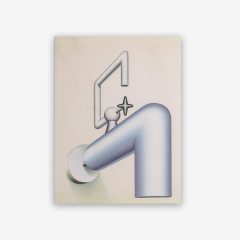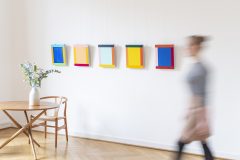Alexej von Jawlensky
Kleiner Kopf
ca. 1922
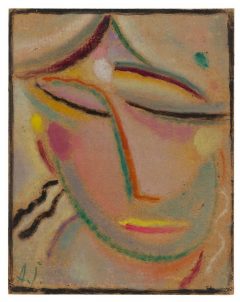
Oil on cardboard
17.5 × 14 cm / 6 7/8 × 5 1/2 in
Signed with the initials
Cataloque Raisonné by Jawlensky/Pieroni-Jawlensky 1991 no. 2248
Miss Ehrod, o. O.; Christel Zapfe, Cologne (inherited from the above, until 1958); Galerie Wolfgang Ketterer, Stuttgarter Kunstkabinett, Stuttgart (auction 20/21 May 1958); Private Collection France (since 1958); Private Collection Belgium (inherited from the above)
- Galerie Ludorff, "Neuerwerbungen Herbst 2021", Düsseldorf 2021
- Espace van Gogh, "Alexej von Jawlensky", 3. April - 30. Juni 1993, Arles
- Galerie Ludorff, "Neuerwerbungen Herbst 2021", Düsseldorf 2021, S. 48
- Maria Jawlensky/Lucia Pieroni-Jawlensky/Angelica Jawlensky, "Alexej von Jawlensky catalogue raisonné of the oil paintings vol. 3 1934-1937", München 1993, Nr. 2248, S. 395
- Espace van Gogh, "Alexej von Jawlensky", Ausst.-Kat., Arles 1993, Nr. 46
Jawlensky has transposed the human head as such into a language of abstract life, has lifted it out of its earthly existence in order to manifest the soul and the spirit. The new laws he found in the process are mathematical ones. He incorporated the laws of the other arts into his paintings: architecture in the balance of colours, music in the tonal rhythm of colours, dance as the line of colours, sculpture as the form of colours, poetry as the content or word of the proclamation of colours, but painting as a symphonic summary. 1)
With the outbreak of the First World War, Russian-born Alexej von Jawlensky was forced to leave Germany. Together with his partner Marianne von Werefkin, the housemaid Helene Nesnakomoff - his lover and later wife - and their son, he moved to Switzerland, where he settled in St. Prex on Lake Geneva. Here, with the series of ‘Variationen über ein landschaftliches Thema’, he began a stringent, serialised working method that would be groundbreaking for the development of his subsequent oeuvre. From 1914 to 1917, in the ‘Variationen’, the artist almost exclusively used the same size of painting cartons, on which he repeatedly captured the view from the window of his small parlour onto the surrounding landscape in an almost identical arrangement. Jawlensky had been devoting himself to portraits since 1905. This occupation intensified from 1917 and resulted in his main work consisting of the portrait series 'Mystische Köpfe', 'Heilandsgesichter', 'Abstrakte Köpfe' and finally the 'Meditationen'.
In Zurich, where Jawlensky moved in 1917, the portrait of Emilie Esther Scheyer (see illus. p. 50), later called ‘Galka’ (Russian: jackdaw) by Jawlensky, a close friend and patron, marked the beginning of his exploration of the female head, which was increasingly simplified and reduced to the essentials in his search for a basic form of portrait. Jawlensky himself describes his turn to the portrait series as a necessary development. I painted these variations for several years, and then it was necessary for me to find a form for the face, as I had understood that great art should only be painted with religious feeling. And I could only bring that to the human face. I understood that the artist must say with his art through forms and colours what is divine in him. That is why the work of art is a visible God, and art is a ‘longing for God. 2) Jawlensky moved to Wiesbaden in 1921, where our colour-harmonious painting ‘Kleiner Kopf’, an outstanding example from the ‘Heilandsgesichter’ group of works, was created a year later.
The face fills almost the entire picture on a light background and is depicted in delicate colours, the large eyes are closed. A green semicircle forms the chin line, above which two parallel lines in yellow and pink describe the closed, expressionless mouth. The nose line, which leads into the left eyebrow, consists of two green and orange-red lines running side by side. The closed eyes describe two black, slightly curved bars. Above them, the hair is indicated in individual strands. A yellow and a pink-coloured circle can be read as cheeks. Individual sections are coloured in light, delicate pastel shades. Despite the strict formal reduction, it radiates great presence. The small format emphasises the impression of intimacy and reinforces the meditative character of the work. Overall, we see in this delicate painting a wonderful example of the successful reduction to the very essential, physiognomic building blocks such as diagonal, vertical and circle and the realisation in harmonious colour perfection.
1) Emmy Scheyer, quoted from Clemens Weiler, ‘Alexej Jawlensky’, Cologne 1959, p. 106.
2) Clemens Weiler, ‘Alexej Jawlensky’, Cologne 1959, p. 102f.
